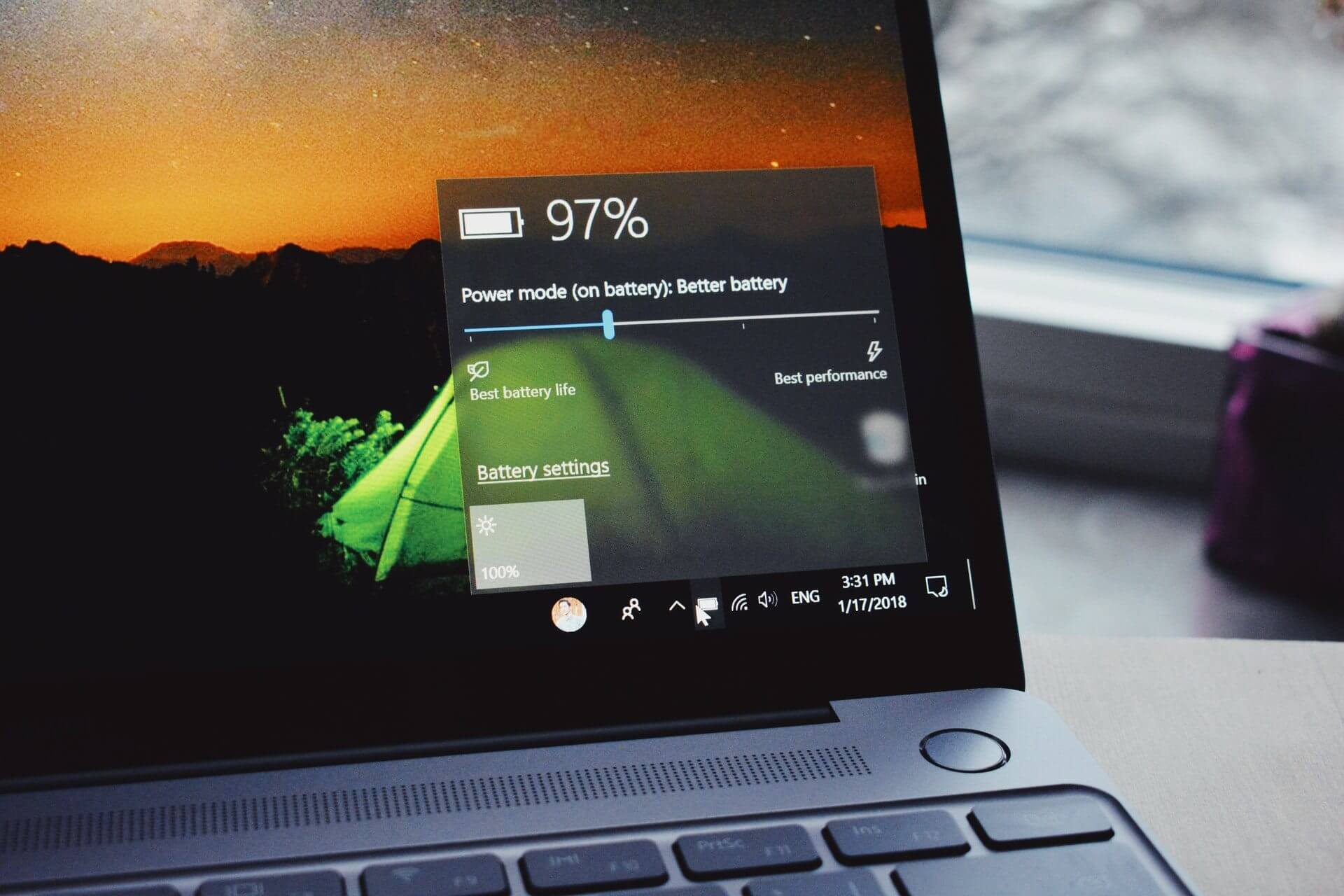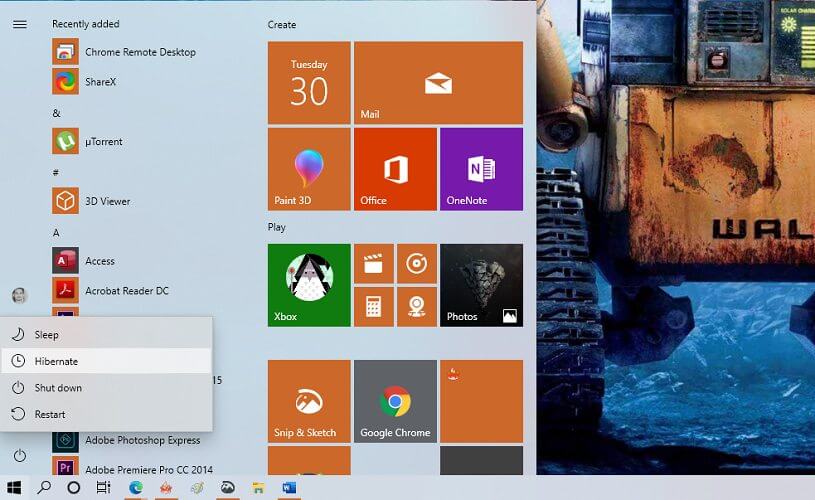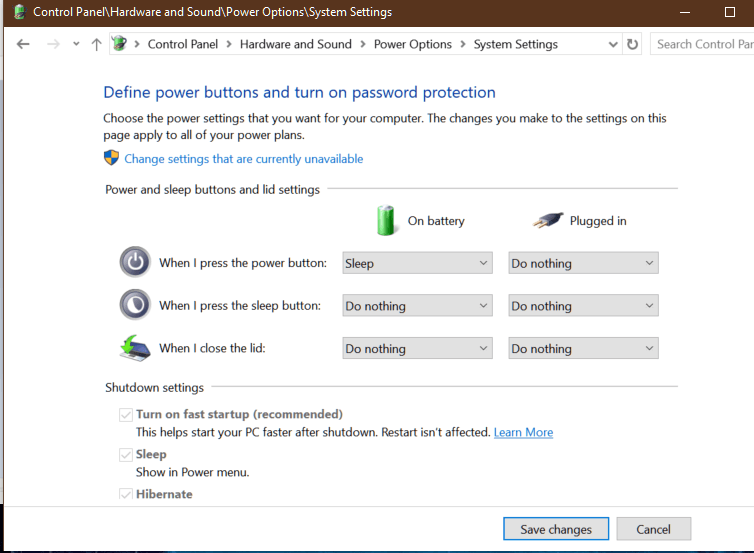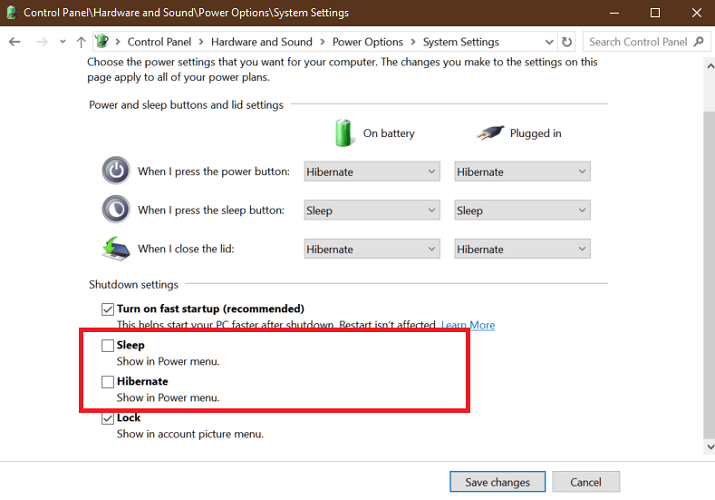- Out of the box, Windows 10 comes with a Sleep and Hibernate option that you can customize according to your preference.
- In this article, we explore the differences between the two power modes and the best practices for your PC.
- Check out our System section for more resources on managing your Windows PC.
- For performance improvements and apps recommendations, check out our Windows 10 Guides section.

Windows 10 by default offers multiple power conserving features to users that includes Sleep mode and Hibernate. Another option is shutdown, which completely shuts your computer, of course.
Sleep mode is the most common power-saving feature that you will come across in laptops. Most of the modern laptops are by default to set to go to sleep after a few minutes of inactivity.
Hibernation is similar to sleep mode but works differently to save more power. Both of these power-saving modes are effective and comes with their pros and cons.
In this article, we take a look at the difference between Hibernate and Sleep mode in Windows 10.
What is the difference between sleep and hibernate in Windows 10?

Sleep Mode
When in Sleep mode, your computer uses very little power. In Sleep mode, Windows saves all the open files and programs in RAM and shut down all other hardware components for the time being.
Having all the files saved in the RAM allows Windows to restore the files and programs as soon as you wake your computer from the sleep.
Hibernate Mode
While both Hibernate and Sleep mode appear similar at first glance, the Hibernate mode works differently and used in a different situation.
When in Hibernation, your computer completely shuts down, drawing no power. However, unlike Sleep mode, the computer saves all the open files and programs in a Hibernation File stored in your hard drive.
When you are ready to resume your work, your computer will load the progress from the hard drive’s Hibernation file. This may take a few seconds or minutes more than waking up from Sleep mode as the files are stored in your hard drive.
In my testing, the computer could get back to work from Sleep mode in about 3 seconds with the lock screen on. However, hibernate mode resumed in over 8-10 seconds that is after saving the Hibernation file in a Samsung 970 Evo Plus NVMe SSD drive.
Is it better to shut down or sleep or hibernate Windows 10?

Sleep – In a situation where you just need a quick break from your work, sleep is the best option. This way, you can save power, but also resume work almost instantly since the file is stored in RAM.
On the flip side, Sleep still uses some battery power to power the RAM that stores the file.
Hibernate – Hibernate works best if you are taking an extended break from your work, but don’t want to deal with the hassle of restarting everything from scratch. This is also good if you want to conserve as much as battery juice as possible when travelling.
That said, Hibernation is not an alternative to shut down. You must shut down your computer once in a while to keep the performance issues at bay.
Shutdown – It is wise to shut down your computer once in a while completely. Restarting your system usually cleans the RAM, helps resolve any performance issue that may occur due to cluttered memory and CPU with background apps and processes.
Is leaving your PC on Sleep bad?

Leaving your PC on sleep mode in itself has no bearing on your system’s overall health. However, some issues may occur due to leaving your PC on sleep mode for an extended period.
Since sleep mode consumes a little power to power the RAM, leaving the PC in sleep mode for an extended period is considered as wastage of resources.
Restarting your PC after shutdown cleans out minor issues that may occur due to temporary glitches. Not shutting down your computer for a long time can impact system performance.
There’s also a risk of random power spikes and surges that can damage your computer in sleep mode or powered on when connected to the power outlet.
Is hibernate bad for SSD?

If you have heard someone saying, using Sleep mode or hibernate will damage your SSD, then it is not totally a myth. Although rare, first-gen SSDs were prone to power failures, and there was also a factor of faster wear and tear due to frequent writes to your SSD.
However, modern SSDs come with superior build and can withstand normal wear and tear for years. They are also less prone to power failures. So, it is fine to use hibernate even if you are using an SSD.
Does hibernate damage the hard disk?
No. Compared to SSDs, HDDs are still popular for their durability. Putting your PC in sleep or hibernate will not damage your hard disk. Hard disk corruption usually happens due to abrupt shutdown.
How can I tell if Windows 10 is hibernating?
When hibernating, your PC will look like its shutdown. Unlike the sleep mode, hibernate will not have the power button LED light blinking. You cannot wake up the computer by pressing a key on your keyboard or mouse either.
However, pressing the power button will bring up the lock screen almost instantly without the boot screen. This is the only way to know if the PC is hibernating.
Is it safe to use hibernate all the time?

Yes. Hibernate simply compresses and stores a copy of your RAM image in your hard drive. When your wakeup the system, it simply restores the files to RAM.
Modern SSDs and hard disks are built to withstand minor wear and tear for years. Unless you are not hibernating 1000 times a day, it is safe to hibernate all the time.
That said, shutting down your computer once every few days is recommended as it helps in clearing your computer’s RAM and freeing up memory and processing power.
Recommended power and sleep settings Windows 10
Sleep

- Click on Start.
- Go to Settings > System > Power & Sleep.
- Open Additional Power Settings.
For laptops & PC – select Choose what the power button does, select Sleep and then click Save changes.
For laptop only – select Choose what closing the lid does. Next, select Sleep, click on Save changes. - Pressing the power button or closing the lid will put your PC in sleep mode.
Hibernate

- Click on Start and select Settings.
- Go to Power & Sleep > Additional power settings.
- Select Choose what the power button does.
- Select Change settings that are currently unavailable.
- Under Shutdown setting, select Hibernate.
- Click Save changes.
- To hibernate the PC, click Start > Power > Hibernate.
If the Hibernate option is not available under Additional power settings, do the following.

- Press the Windows key, and type cmd.
- Right-click on Command Prompt and select Run as Administrator.
- In the Command Prompt window, type the following and hit enter:
powercfg.exe/hibernate on. - Go to Additional power settings to see if the Hibernate option is available now.
Change the power plan

- Press the Windows key, and type sleep.
- Open Power and Sleep settings.
- Select Additional power settings.
- In the Power Options window, you have three options:
Power saver – In this mode, Windows will save power by reducing the performance and brightness.
Balanced mode – For balanced performance and battery backup.
Performance mode – Recommended when you are using the laptop plugged in.
How to turn off sleep and hibernate mode in Windows 10

Turn off Sleep
- Click on Setting.
- Go to System > Power & Sleep.
- Scroll down to Sleep.
- Click the drop-down menu for both ‘On battery’ & ‘When plugged in’.
- Select Never.
Disable Hibernate / Sleep
- Click on Start > Settings > System.
- Open Power and Sleep.
- Click on Additional Power Settings.
- Under Power and sleep button and lid setting, click the drop-down menu for ‘On battery’ and ‘Plugged in’.
- Select Do Nothing.
- Click Save changes.
Disable Sleep/Hibernate from shutdown settings

- Open Additional power settings.
- Click on Change settings that are currently unavailable.
- Under Shutdown settings, uncheck Sleep and Hibernate
- Click Save changes.
- This will remove both the Sleep and Hibernate option from your power menu.
Hibernate and Sleep mode in Windows 10 are designed for specific purposes. Sleep option is excellent for saving power during a short break.
Hibernate, on the other hand, makes sense if you know you won’t be using your computer for a while, but don’t want to manually open the apps and files when you work again.
FAQs: Learn more about hibernate and sleep in Windows 10
- Which is better Hibernate or Sleep?
Both Hibernate and Sleep are designed as power-saving features for Windows 10 laptops. You can use Sleep when taking a short break from work and Hibernate if the computer will be idle for a few hours.
- Why don’t I have the hibernate option in Windows 10?
Some Windows 10 laptops may not have the Hibernate option in power settings. However, you can enable it using the powercfg.exe hibernate/on command.
- What happens in sleep mode?
In sleep mode, the computer saves all the open files and programs in RAM and cuts power to other computer components. Waking up your computer from sleep will restore the files almost instantly.
and
If you are looking for a cheap and genuine microsoft product key, warranty for 1 year.
It will be available at the link: https://officerambo.com/shop/
Microsoft Windows Embedded 8.1 Industry Pro : https://officerambo.com/product/windows-embedded-8-1/
Key Windows 7 Professional / Home Base / Home Premium (2 USER) : https://officerambo.com/product/key-windows-7/
Microsoft Windows 8.1 PRO (2 PC) : https://officerambo.com/product/microsoft-windows-8-1-pro/
Windows Server 2012 R2 : https://officerambo.com/product/windows-server-2012-r2/
Visual Studio Enterprise 2019 : https://officerambo.com/product/visual-studio-enterprise-2019/
Windows Server Standard / Datacenter / Essentials : https://officerambo.com/product/windows-server-all-version-standard-datacenter-essentials/
Microsoft Office Professional Plus for Windows : https://officerambo.com/product/microsoft-office-professional-plus-for-windows/
Microsoft Office Home and Student for Windows : https://officerambo.com/product/microsoft-office-home-and-student/
Key Microsoft Access 2016 : https://officerambo.com/product/key-microsoft-access-2016/
Microsoft Visio Professional : https://officerambo.com/product/microsoft-visio-professional/
Microsoft Project Professional : https://officerambo.com/product/microsoft-project-professional/
Account Microsoft Office 365 Profestional Plus 2020 Update For 5 Devices : https://officerambo.com/product/account-microsoft-office-365/
Key Microsoft Windows 10 Profestional / Profestional N : https://officerambo.com/product/key-microsoft-windows-10/
Key Microsoft Windows XP Pro : https://officerambo.com/product/key-microsoft-windows-xp-pro/
Microsoft Office Home and Business for Mac : https://officerambo.com/product/microsoft-office-home-and-business-for-mac/
No comments:
Post a Comment